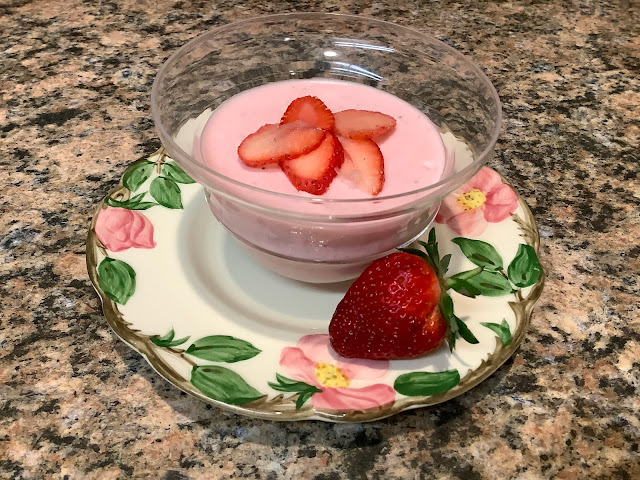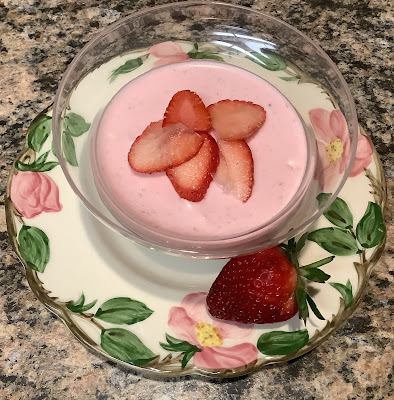
Recipe: Easy fresh strawberry mousse lets flavor shine
 |
| This easy strawberry mousse contains no eggs. (Photos: Debbie Arrington) |
My garden yielded a bounty of fresh strawberries, the first of the season. How to celebrate? With a dessert that feels just as special as those first fresh-picked berries: Strawberry mousse.
Like anything French (at least food-wise), mousse comes with a reputation. Rich and silky chocolate mousse, packed with eggs as well as cream, is synonymous with decadent desserts.
By contrast, this strawberry mousse is light and airy, with no eggs. Without too much sugar, the strawberry flavor really comes through. Pushing the pulp through a sieve removes the many seeds and yields a mousse with a wonderfully smooth texture. This method would also work with stone fruits and other berries, such as blackberries.
Mousse is easier to make than it sounds; just take it step by step. It takes some preparation time, but the results will taste as special as those first strawberries.
Easy fresh strawberry mousse
Makes 4 servings
Ingredients:
2 cups strawberries, hulled and pureed (about 1 pound)
½ cup granulated sugar
2 tablespoons Cointreau or other liqueur (optional)
1/8 teaspoon salt
1 tablespoon (1 packet) powdered gelatin
2 tablespoons warm water
1 cup heavy whipping cream
¼ powdered sugar
1 teaspoon vanilla extract
Sliced strawberries or other garnish
Instructions:
Wash and hull strawberries. Process in a food processor until pureed or mash by hand. In a large bowl, combine pureed strawberries and granulated sugar. Let sit 30 minutes to bring out the berries’ juices. Push the strawberry pulp and juice through a sieve to remove seeds and heavy fibers. You should have about 1-1/2 cups strained strawberry puree and juice. Add salt and the Cointreau or liqueur, if using; set aside.
In a glass measuring cup or small microwave-safe bowl, mix powdered gelatin with warm water until gelatin is dissolved. Let sit 3 minutes. Microwave gelatin mixture for 20 seconds on high to heat and melt the gelatin. Add ¼ cup of strawberry puree to gelatin mixture, then add gelatin mixture to strawberry puree. Stir gently to combine.
Either with an electric mixer or food processor, whip together whipping cream, powdered sugar and vanilla until stiff peaks form. Gently fold whipped cream into strawberry puree mixture, stirring just enough that the color looks even and not striped with white.
Transfer mixture into serving dishes and chill at least 2 hours. Garnish, if desired, and serve.
Note: This mixture may also be chilled in a mold. Wet inside of mold first. Chill at least 4 hours.
 |
| Be sure to garnish it with more strawberries. |
Comments
0 comments have been posted.Sacramento Digs Gardening to your inbox.
Food in My Back Yard Series
May 6: Maintain soil moisture with mulch for garden success
April 29: What's (already) wrong with my tomato plants?
April 22: Should you stock up on fertilizer? (Yes!)
April 15: Grow culinary herbs in containers
April 8: When to plant summer vegetables
April 1: Don't be fooled by these garden myths
March 25: Fertilizer tips: How to 'feed' your vegetables for healthy growth
March 18: Time to give vegetable seedlings some more space
March 11: Ways to win the fight against weeds
March 4: Potatoes from the garden
Feb. 25: Plant a fruit tree now -- for later
Feb. 18: How to squeeze more food into less space
Feb. 11: When to plant? Consider staggering your transplants
Feb. 4: Starting in seed starting
Sites We Like
Garden Checklist for week of May 11
Make the most of the lower temperatures early in the week. We’ll be back in the 80s by Thursday.
* Plant, plant, plant! It’s prime planting season in the Sacramento area. Time to set out those tomato transplants along with peppers and eggplants. Pinch off any flowers on new transplants to make them concentrate on establishing roots instead of setting premature fruit.
* Direct-seed melons, cucumbers, summer squash, corn, radishes, pumpkins and annual herbs such as basil.
* Harvest cabbage, lettuce, peas and green onions.
* In the flower garden, direct-seed sunflowers, cosmos, salvia, zinnias, marigolds, celosia and asters. (You also can transplant seedlings for many of the same flowers.)
* Plant dahlia tubers.
* Transplant petunias, marigolds and perennial flowers such as astilbe, columbine, coneflowers, coreopsis, dahlias, rudbeckia and verbena.
* Keep an eye out for slugs, snails, earwigs and aphids that want to dine on tender new growth.
* Feed summer bloomers with a balanced fertilizer.
* For continued bloom, cut off spent flowers on roses as well as other flowering plants.
* Add mulch to the garden to maintain moisture. Mulch also cuts down on weeds. But don’t let it mound around the stems or trunks of trees or shrubs. Leave about a 6-inch-to-1-foot circle to avoid crown rot or other problems.
* Remember to weed! Pull those nasties before they set seed.
* Water early in the day and keep seedlings evenly moist.